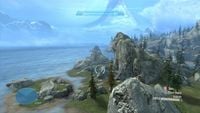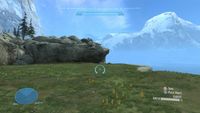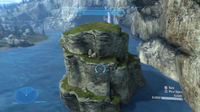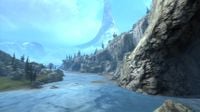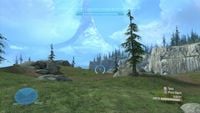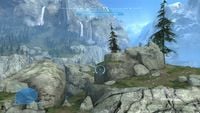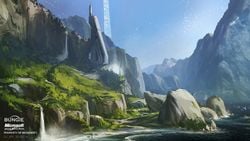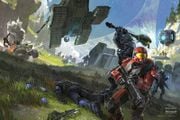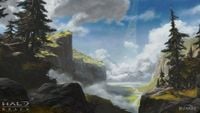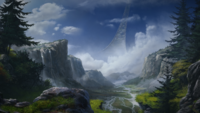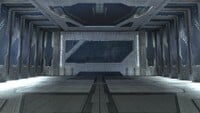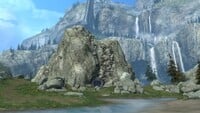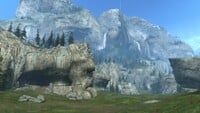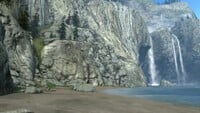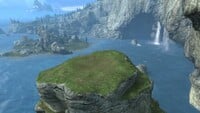Forge World
From Halopedia, the Halo wiki
| Forge World | |
|---|---|
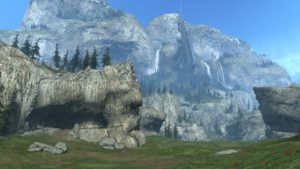
| |
| Map overview | |
|
Game: |
|
|
Map file name (?): |
|
| Lore information | |
|
Location: |
|
| Gameplay overview | |
|
Terrain: |
Mountainous cliffsides, taiga landscapes, islands, Forerunner structures. |
|
Recommended gametype(s): |
|
| “ | A blank canvas recommended for Forge editing only. | ” |
Forge World is a multiplayer map in Halo: Reach intended for use as a "blank canvas" for Forge. The map encompasses several different regions and environments which allows users to create entirely new maps of varying sizes, similar to the three distinct areas in Sandbox.[3] It is the only non-DLC map to feature the full suite of Building Block Forge objects.
Universe and lore[edit]
Forge World is set on a miscellaneous Halo ring, set within the War Games simulations hosted by the United Nations Space Command as opposed to being a physical location.[2] The Forge World area itself is set closer to the edge of the ring, with the Halo arcing up into the sky at an angle as opposed to directly up. Forge World is an amalgamation of various locations encountered on other Halo Rings, including a Relay station seastack and a canyon reminiscent of "Blood Gulch".
Overview[edit]
Layout[edit]
Callouts[edit]
The following are locations on the map that are so named on the player's heads-up display during gameplay:
The Canyon[edit]
The "Canyon" is a semi-enclosed, symmetrical canyon in the south of the map with a large open field and a drying river in its center. Along the edges of the canyon are several walkways and caves. One end of the canyon opens up into the lake while the other can be ascended into Alaska. The Canyon is designed for easy traversal in ground vehicles and is recommended for larger, team-based games. Other than an increase in size and some environmental changes, this area of the map is a faithful and accurate remake of the Blood Gulch canyon. The terrain of the canyon was taken from Halo 2's Coagulation and "rezzed up" to ensure the terrain was accurate.[4]
The Island[edit]
The "Island" is a large area in the center of the map. The Island is roughly symmetrical, with a large rock formation at the center and a small bay on one side that molds this area into a horse-shoe shape. There is a small tunnel that cuts through the center rock. The Island is designed for vehicular combat and is recommended for larger, team-based games. The Island was designed to be vaguely reminiscent of Sidewinder, thus the horse-shoe shape of the map.
The Quarry[edit]
The "Quarry" pocket is a small roughly rectangular grassy patch enclosed on three sides by rock cliffs with a view overlooking the entirety of the map on the fourth side. The Quarry is positioned directly above the Coliseum section of the map. The Quarry is described as about the same size as Sanctuary and a remake of Sanctuary, Asylum, is built here.
The Coliseum[edit]
The "Coliseum" is an enclosed area reminiscent of the Crypt from Sandbox and appears to be made of Forerunner alloys. The entrance to this area is located directly under the Quarry on the side of the cliff in the far north corner of the map. This area of the map was designed to give forgers a traditional area to forge. The entrance side of the Coliseum can be blocked off with a forge piece designed specifically with this in mind or left open to give players a view of the lake.
The Pillar[edit]
The "Pillar" is a tall spiraling column of rock stretching out of the lake in the same general vicinity of the map as the Quarry and the Coliseum. The Pillar has been referred to by Bungie as "The Rock", despite the fact that this location is named "Pillar" in players' HUDs. It was modeled after the level Ascension from Halo 2.
The Coastline[edit]
The "Coastline" area applies to all locations along the coast where another area does not intersect with itself; because of this the majority of the Coastline area is on top of water from the lake. The majority of playable space (actual land) in the Coastline area is a stretch of beach positioned in between Alaska and the Island; this area of the Coastline features a large cave at one end and multiple spots to forge across a small inlet to reach the island.
The Lagoon[edit]
The "Lagoon" is a large sea cave positioned along from the end of the Coastline area of the map, and is located below and to one side of the Coliseum's cliff entrance. The Lagoon features three cascading waterfalls and a large cliff face with a half-dome hollow cave reaching in. It is also adjacent to the Island, which can be seen clearly from the area. The Lagoon is also the site of Bungie Representative Urk's first Forging attempt, first entitled Jurkout, then Riptide, featuring several platforms just below the surface of the water. The Lagoon is the only area of Forge World with no solid land (aside from the top of the cliff). The waterfall area of Lagoon was created for housing an official remake of the Halo 2 map Lockout, which was described as being at "95% completion" but was never shipped.[5][6]
Alaska[edit]
"Alaska" is a grassy area surrounded by cliff faces on all sides. It is positioned in between the Coastline and the Canyon. A small gully leads down into the Canyon from one side of the map. Alaska and Montana are similar in their classic Halo terrain appearance. Notable differences, however, are Alaska's lack of visible terrain cliffs or edges, instead having only rolling hills. It also features scattered trees, which cannot be moved or deleted due to technical constraints on the part of Bungie.
Montana[edit]
"Montana" is a rocky, mountainous area of the map taking place on top of a plateau. Montana is positioned in between the lake and the Canyon, forming one of the Canyon's walls. While sharing a classic Halo terrain appearance, Montana differs from Alaska in appearance in that its terrain is generally more rough, rugged, and varied with fewer flat sections. The terrain is heavily populated by rocks and similar environmental pieces, which cannot be moved or deleted. One end of this area is narrower with more rocky ledges as well as a small spiral structure. The other end gradually opens up and is less rugged.
Variants[edit]
The following map variants are included with Halo: Reach. These map variants were developed by Bungie using the Forge 2.0 tool set in order to demonstrate Forge 2.0's increased user-friendly capabilities.
Forge[edit]
- Main article: Forge
Almost all weapons and vehicles can be spawned on Forge World, but none appear on the map by default. These are the base vehicles that are available through Forge.
- Warthog
- Gauss Warthog
- Rocket Warthog
- Mongoose
- Scorpion
- Falcon
- Rizvum-pattern Revenant
- Banshee
- Ghost
- Shade Turret
Forge World is one of two maps, the other one being Tempest, that received the Thorage update in Halo: The Master Chief Collection.
Production notes[edit]
Forge World was first revealed to the public through a Red vs Blue Public service announcement[7] requested by Bungie in celebration of Bungie Day 2010. This video led fans to believe that the map was a remake of Blood Gulch from Halo: Combat Evolved, but teased fans with "Go outside the Canyon". The true nature of Forge World was revealed in the Forge World ViDoc on July 22, 2010.
Forge World began development as a remake of the Halo 3 Forge map Sandbox, set in an under-construction skyscraper in the city of New Alexandria.[4] As the "fixed" and "phased" item settings were greenlit for development, the developers realized they didn't need to ship a flat terrain like Foundry or Sandbox, as players would be able to create their own with the Forge mode. Bungie also knew they wanted to create five multiplayer maps, but only had time for the art team to create one skybox, and a limited palette of items to put in the maps. Because of this, the original intention was to build five different terrains - a spire, a cliff, a gulch, a canyon and a room - all set under the same skybox and with "hints" of the other four maps further away, such as being able to see a canyon that looked like the gulch from the quarry. To aid development, designer Steve Cotton had an internal build of the level that featured all five maps compiled into one level to allow him to work on each level faster. Upon realizing that the map ran well and looked good when compiled, Cotton pitched the idea to the team at Bungie, who advised him against it. Cotton did it anyway.[4]
Because of a new system in Halo: Reach's game engine called "impostering", which allows distant objects to be drawn cheaply, it was decided that it was feasible to actually allow players to play across the entire expanse of the development map.[8] At this point, the five maps were combined into a single map later dubbed "Forge World".
After the five original maps were combined to create Forge World, four new areas were added to the map between them, giving Forge World a total of nine regions and making it the then-largest multiplayer map in the series.
Trivia[edit]
- Forge World has a maximum budget of 10,000 credits, the largest budget allowed of any of the Forge maps in Halo: Reach or Halo 3.
- Forge World and Tempest are the only maps in Halo: Reach where players have access to the "Structures" objects menu tab while Forging.
- To the left of the Coliseum there is a mountain, and the indents and trees around the mountains form what slightly resembles a skull.
Gallery[edit]

|
Browse more images in this article's gallery page. |
Sources[edit]
- ^ Halo: Reach Editing Kit, game file
HREK\tags\levels\multi\forge_halo\forge_halo.scenario - ^ a b YouTube - Halo, Halo Lore Stream: The Halo Array: 1:06:39 "Most of the Forge World stuff [...] that's in simulation territory" - Kenneth Peters
- ^ Bungie.net, Forge World ViDoc (Retrieved on Jan 31, 2021) [archive]
- ^ a b c Bungie.net, Bungie Weekly Update 07.23.10 (Retrieved on Jan 31, 2021) [archive]
- ^ halo.bungie.org, So, the 'official' Lockout remake DID exist. (Retrieved on Apr 14, 2023) [archive]
- ^ halo.bungie.org, So, the 'official' Lockout remake DID exist.: "It was next to the waterfalls. That space was carved out specifically for it." - Shishka (Retrieved on Apr 14, 2023) [archive]
- ^ Bungie.net, Bungie Day "Deja View" (Retrieved on Jan 31, 2021) [archive]
- ^ Halo: Reach marketing, Halo: Reach ViDoc: Forge World
| ||||||||||||||||||||||||||||||||||||||||||


